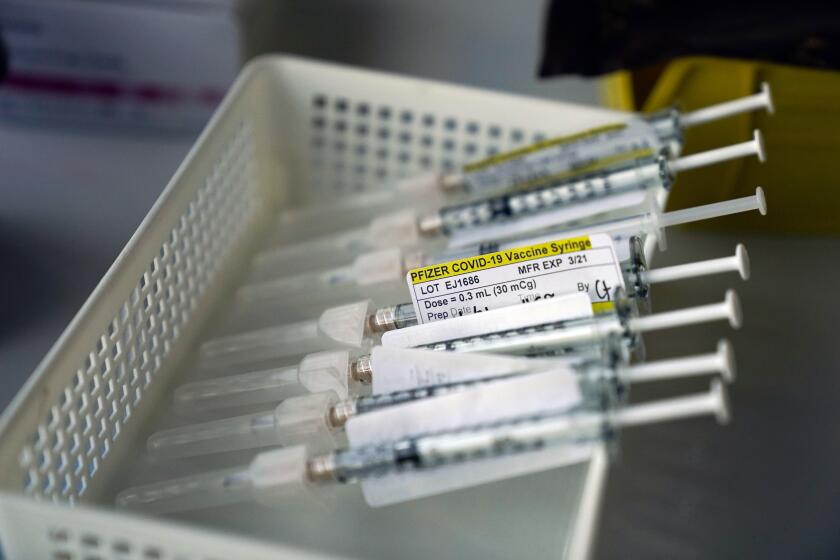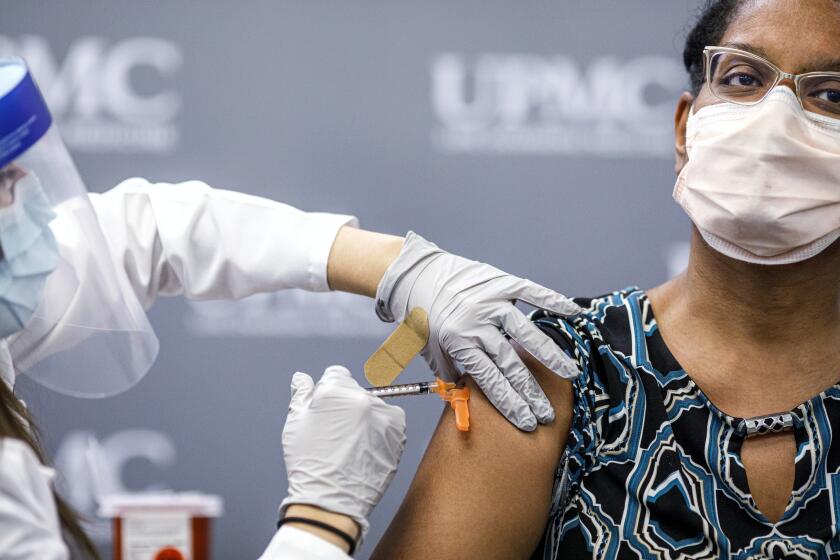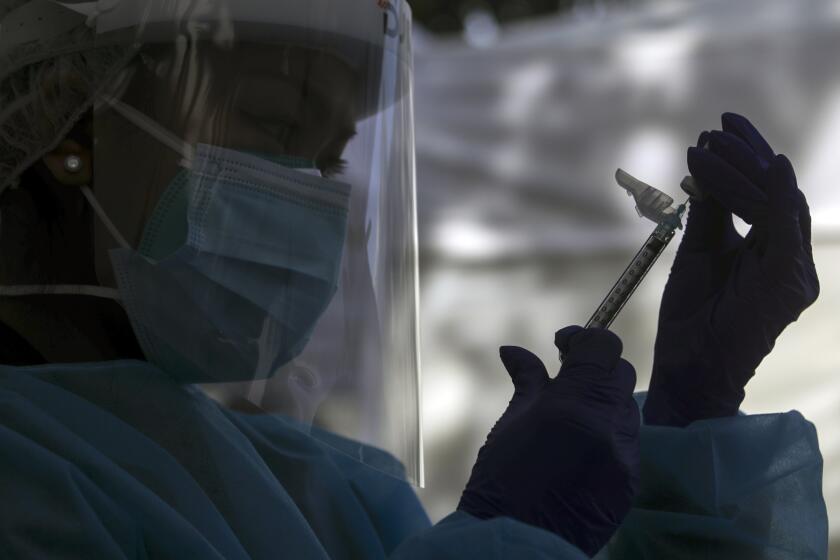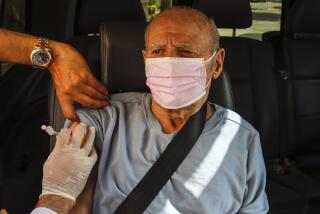California allows residents 65 and older to get COVID-19 vaccine, but doses remain limited
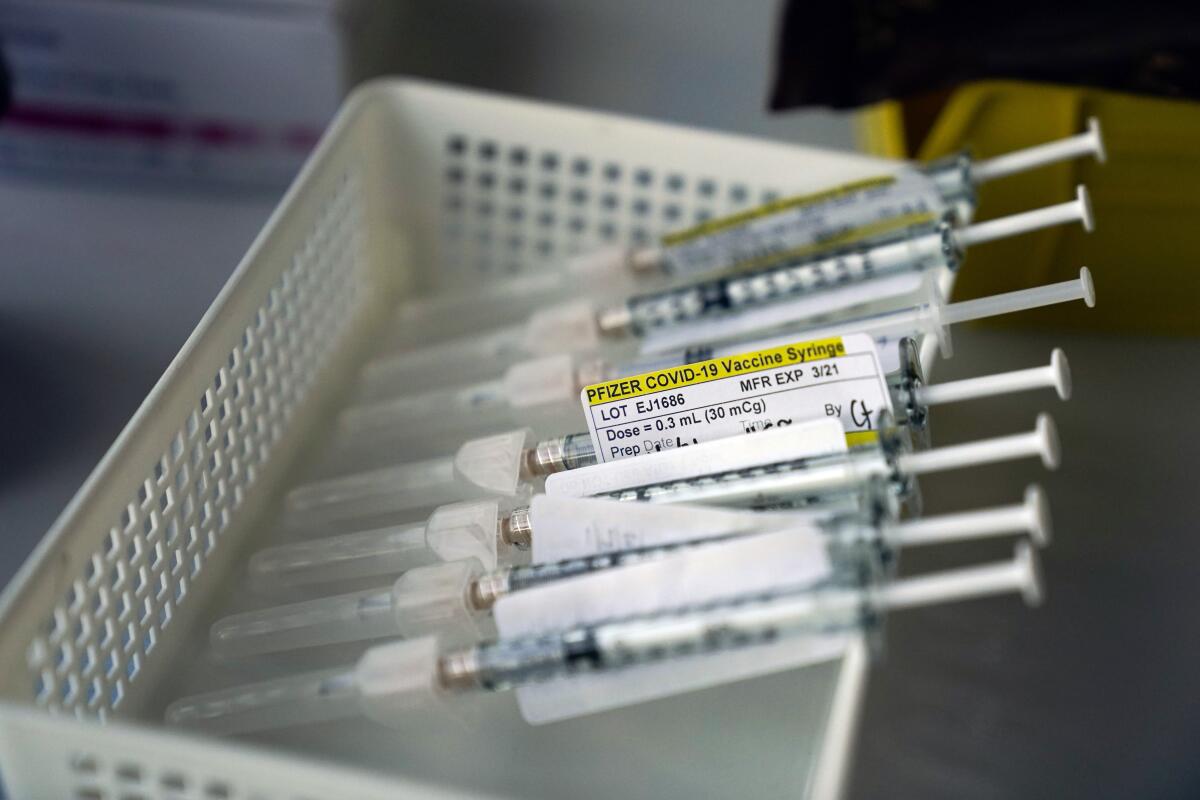
- Share via
SACRAMENTO — Gov. Gavin Newsom announced Wednesday that people 65 and older are now eligible for COVID-19 vaccinations, but the sudden addition of roughly 6 million people to an already strained distribution network could still leave many waiting weeks for inoculations.
The major expansion of vaccination guidelines, which broadens the priority list beyond healthcare workers and nursing home residents and staffers, has been pushed by some health officials and experts as a way to boost access amid surging caseloads. Newsom and others said it was a positive step forward that will provide access as quickly as possible to people 65 and older, a group that has suffered disproportionately from the virus.
“There is no higher priority than efficiently and equitably distributing these vaccines as quickly as possible to those who face the gravest consequences,” Newsom said in a statement.
But the announcement was met with confusion and pleas for more details from some county health officials, raising questions whether state and local officials are prepared to meet growing demands and expectations for vaccinations. County officials across the state cited an array of ongoing problems that has contributed to the slow rollout, ranging from insufficient doses to not enough healthcare workers who are able to administer vaccine.
Those seeking vaccines have also complained about a scarcity of information on how to make an appointment. Residents on Wednesday flocked to vaccine registration portals, but in some instances, could not load the site — likely due to high traffic. Some county websites were not updated prior to the announcement to communicate who is now eligible.
In Los Angeles, public health officials said people 65 and older won’t have access to the vaccine until the county finishes vaccinating front-line workers. The county plans to vaccinate 500,000 more healthcare workers by the end of January, but currently does not have enough doses to meet that goal.
“We’re not done with our healthcare workers,” said LA County Public Health Director Barbara Ferrer, adding that the county has asked the state for more doses. “We haven’t heard back from the state about vaccine availability and how it would be distributed.”
As of last week, L.A. County had administered only about 151,000 doses of the more than 490,990 it has received.
In Santa Clara County, providers are ready to expand vaccine access to all adults 75 and older, but officials say that the county needs more doses. The county asked the state for 100,000 more doses but was told this week it would receive 6,000, said Dr. Jeff Smith, county executive.
The shifting pool of who is eligible has complicated the county’s plans on how to distribute the vaccines. “We’re getting confusing and inconsistent messaging,” Smith said.
California officials have struggled thus far to distribute its allotment of vaccine doses. As of Tuesday, more than 2.8 million doses have been shipped to California, but less than one-third had been administered. There has been lower than expected demand from the healthcare and nursing home workers who have highest priority to receive the vaccines, with up to 40% declining the initial opportunity to be vaccinated.
Ahead of the announcement, some counties have been moving to create mass vaccination sites. At Dodger Stadium, officials are scheduled to open facilities for vaccinations by Friday, and hope to eventually provide up to 12,000 daily doses.
At Disneyland, more than 10,000 people signed up for vaccinations in less than two hours Tuesday. Orange County set a goal to vaccinate more than 7,000 people per day at the site.
Newsom on Wednesday promised more help with vaccine rollouts to achieve his ambitious target of vaccinating an additional 1 million people over the course of 10 days ending Jan. 17.
He announced a new system to let people know when they are eligible to receive a vaccine, but there were no additional details other than it is expected to launch next week. The governor’s office also said a “second phase” of that system will help counties, cities and providers run mass vaccination events for which people could schedule appointments. But that second phase is not expected to be ready for several weeks.
The decision followed new guidance issued Tuesday from the Centers for Disease Control and Prevention, and came ahead of the official recommendation from the state.
California’s decision to open up eligibility for vaccine comes after federal officials pushed states to take swifter action distributing doses. U.S. Health and Human Services Secretary Alex Azar said Tuesday that states had simply moved too slowly and that lifesaving vaccine should be doled out immediately.
“That is the most effective way to save lives now,” Azar said, “and some states’ heavy-handed micromanagement of this process has stood in the way of vaccine reaching a broader swath of the vulnerable population more quickly.”
New federal guidelines call for anyone 65 and older to qualify now for the Pfizer-BioNTech and Moderna vaccines. In addition, the federal guidelines say anyone age 16 to 64 with a documented medical condition should also qualify now.
Azar said state regulations limiting who was eligible had “obstructed speed and accessibility” of the vaccines. He added that the federal government will release all of its available vaccine instead of holding back a reserve for second doses.
To push states into making vaccines more readily available, Azar said the federal government was providing two weeks’ notice that future doses would be released to states based on how effectively each used its existing supplies.
“It gives states a strong incentive to ensure doses are going to work protecting people, rather than sitting on shelves or in freezers,” Azar said. “With the case counts we face now, there is absolutely no time to waste.”
New York Gov. Andrew Cuomo announced Tuesday that the Empire State would follow the federal guidelines to drastically open availability, despite concerns about too few vaccines and problems with the state’s system to make appointments.
President Trump asks states to speed delivery of COVID-19 vaccines to those at higher risk by no longer holding back the second dose.
Prior to the federal push, California planned to allow individuals in certain job sectors, such as education and agriculture, along with adults 75 and older, to be vaccinated next, followed by individuals 65 to 74. Under the new guidelines, the state lowered the age threshold to 65 years and older, bumping that group up to priority access.
“California is in the middle of a surge and as we look at hospitalizations and deaths, we see that 75% of deaths are individuals 65 and older,” said California Surgeon General Dr. Nadine Burke Harris. “We want to distribute as many doses as possible.”
The state, however, will not follow federal guidance calling for individuals 16 to 65 with medical conditions to be eligible now for the vaccine. California has those individuals in the next tier.
Wednesday’s eligibility expansion poses significant challenges. California counties are scrambling to find more healthcare professionals who can administer the shots, large facilities where inoculations can be offered, and more of the vaccines themselves.
Los Angeles County will officially expand the eligibility of vaccine recipients starting Monday, following guidance from the state.
Some members of the state’s vaccine advisory committee expressed concern in a meeting Tuesday that, with the focus on age, individuals who might face other vulnerabilities could be lost in the shuffle. Others have raised concern that at-risk individuals, including essential workers, could be overlooked as the doors open for a wider pool of eligible vaccine recipients.
“When you add this big group of people, you end up with not enough vaccine,” Carol Green of the California State Parent Teachers Assn. said at the meeting.
Times staff writer Hannah Fry contributed to this report.
More to Read
Sign up for Essential California
The most important California stories and recommendations in your inbox every morning.
You may occasionally receive promotional content from the Los Angeles Times.
